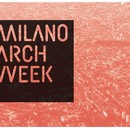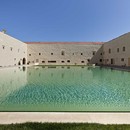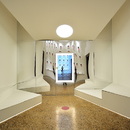Biography
Originally from New Jersey, Peter Eisenman (1932) has always had a deeply-rooted cultural connection with European intellectuals, historians and artists, including Rowe, Tafuri, Chomsky and Derrida, who influenced his design concepts.His architectural and urban planning projects, and above all his long career in theory and education, position him “close to conceptual art” and to deconstructivism, with a strong experimental component and constant search for dialog between opposites and disciplines apparently unconnected to conventional architecture (for example, philosophy, semantics and linguistics).
A profound connoisseur of Italian rationalism (...) he has designed residential and town planning schemes, innovative private houses and public buildings, always in search of a dialog between opposites." (Treccani)
The link with Italy is particularly long-standing. Eisenman visited the country for the first time in the summer of 1961, during his time as a lecturer at Cambridge. He therefore came into contact with the work of classical architects, such as Scamozzi, Vignola and Palladio, who subsequently influenced his ideas. The last-mentioned was the subject of his splendid exhibition at Yale University in 2012.
Eisenman was the main exponent of the group known as the New York Five (or Five Architects) - taken from the name of their collective exhibition at MoMA (1967) and the book Five Architects (1972) - alongside John Hejduk, Michael Graves, Charles Gwathmey and Richard Meier. The group was inspired by Le Corbusier’s work and Modernism in general.
During this time Eisenman founded the Institute for Architecture and Urban Studies (IAUS, 1967), an international architecture think tank in New York, serving as director until 1982, in addition to editing the magazine Oppositions (1973-82). His design analysis theories are published in numerous books, including The Formal Basis of Modern Architecture: Dissertation (1963) and Giuseppe Terragni (1985).
Eisenman is a great admirer and connoisseur of the Italian rationalist architect since his first visit to Italy in 1961, stating: "in front of Terragni’s Casa del Fascio, emblematic of rationalism, I had an epiphany. I was stunned, I had never seen architecture like this" (interview with F. Erbani in La Repubblica, 2015).
His early work was primarily theoretical. Eisenman later became known for his numerous housing designs which caused heated debate (House I in Princeton, 1967-68, House VI in Cornwall, 1972), due to "often controversial experimentation” which culminated in the multi-disciplinary complex and international laboratory at the Wexner Center for the Visual Arts, Ohio State University, Columbus (1983-89).
The unconventional modular construction, with geometric and time sequences (Houses I-XI), is only apparently fragmentary and irreverent.
In fact, these houses constitute a new set of construction rules, which due to certain characteristics is defined as Cardboard Architecture.
A further stage in his production began in the Eighties when he designed projects such as the Greater Columbus Convention Center (1989-93), Koizumi Sangyo (1988-90), Aronoff Center, DAAP - University of Cincinnati College (1996), Nunotani Building (1990-92), Tokyo, Holocaust Monument in Berlin (1998-2005) and University of Phoenix Stadium (2006, now State Farm Stadium).
His numerous projects also include "the multi-block development on the West Side, Manhattan (1999), Spree Dreieck Tower, Berlin (2000), FSM East River project in New York (2001), new high-speed train station, Naples (2003),and Sheikh Zayed National Museum in Abu Dhabi (2007)".
Alongside his construction work, Eisenman has continued his academic career, teaching at prestigious universities such as Cambridge, Princeton, Harvard and Yale, where he is currently a lecturer.
A member of the American Academy of Arts and Sciences and American Academy of Arts and Letters, Eisenman has also won numerous prestigious international awards including the Gold Medal, New York Chapter of the American Institute of Architects and National Design Award for Architecture from Cooper-Hewitt National Design Museum (both in 2001), Golden Lion for Lifetime Achievement at the Venice Architecture Biennale in 2004 and Wolf Foundation Prize in the Arts (2010).
His numerous publications include Inside Out, Selected Writings 1963-1988, published by Yale University Press in 2004 and released in Italy ten years later by Quodlibet, in which he scrupulously analyses and details his many projects designed during this major period in his literary-construction career.
Peter Eisenman selected works and projects
- Yenikapi Archaeological Museum and Archeo-park (con Aytac architects), Istanbul (Turchia), 2012 (progetto) - 2020 (inizio previsto dei lavori)
- Babyn Yar Holocaust Memorial Center (progetto), Kiev (Ucraina) 2019
- Hungarian Museum of Transport (progetto), Budapest (Ungheria), 2019
- Budapest South Gate (progetto), Budapest (Ungheria), 2018
- Guggenheim Helsinki Museum (progetto), Helsinki (Finlandia), 2016
- Liget Budapest House of Music (progetto), Budapest (Ungheria), 2015
- Taichung City Cultural Center (progetto), Taichung (Taiwan), 2013
- Installazione e mostra "Palladio Virtuel", Yale School of Architecture, New Haven, Connecticut (USA), 2012
- Pozzuoli Waterfront Masterplan (progetto), Pozzuoli (Italia) 2009
- Pinerba Condominium, Pinerba, Milano (Italia), 2009 - in corso
- State Farm Stadium (aka University of Phoenix Stadium), Glendale, Arizona (USA), 2006
- Memoriale dell’Olocausto, Berlino (Germania), 2005
- Mostra “Il giardino dei passi perduti”, Museo di Castelvecchio, Verona (Italia), 2004
- FSM East River Project, New York (USA), 2001
- Città della Cultura della Galizia, Santiago de Compostela (Spagna), 1999 - in corso
- The Aronoff Center, DAAP - University of Cincinnati College, Cincinnati, Ohio (USA), 1996
- Greater Columbus Convention Center, Columbus, Ohio (USA), 1993
- Nunotani Corporation Headquarters Building, Tokyo (Giappone), 1992
- Masterplan Rebstockpark, Francoforte (Germania), 1991
- Koizumi Sangyo Office Building, Tokyo (Giappone), 1990
- Video-Music Pavillon, Groningen (Olanda), 1990
- Wexner Center for the Arts, Columbus, Ohio (USA), 1989
- Biocentrum, Francoforte sul Meno (Germania), 1987
- University Art Museum, Long Beach, California (USA), 1986
- IBA Social Housing, Berlino (Germania), 1985
- Firehouse, Brooklyn, New York (USA), 1985
- House XI - Palo Alto, California (USA), 1978
- House X, Bloomfield Hills, Michigan (USA), 1975
- House VI - Frank residence, Cornwall, Connecticut (USA), 1972
- House II - Falk House, Hardwick, Vermont (USA), 1969
Official website
www.eisenmanarchitects.com
Interview
They were great movies at that time, but if you see them today you feel nothing. Because we have changed, and it is the same with architecture. One of my favourite films back then was "Hiroshima Mon Amour" by Alain Resnais. I saw recently a film called "Lost in Translation" by Sophia Coppola which is the same idea, it's Japan, it's an older man with a younger woman, etc., but the difference between these two film to me describes the difference between 1965 and 2005.Sophia Coppola film is a fantastic architectural movie as was "Hiroshima Mon Amour": the story for me is secondary, but the visual impact of that movie is amazing! Architecture has to come to terms with this. We have to find a way to do the same things that Antonioni was doing or that Fellini was doing or Bellocchio or Rosi but now, today. And for an architect it is the same: you cannot do the same thing that Le Corbusier was doing or that Palladio was doing, we have to deal with the sensibility that we find today.
ou know, my kids can't sit still, they have to be listening to music, they can't read like we used to, they can't deal with the environment in the same way, they need something happening all the time.
Related Articles: Peter Eisenman
Related Articles










